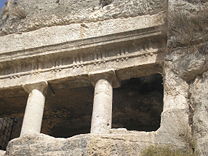
Bnei Hazir tomb
Encyclopedia


Kidron Valley
The Kidron Valley is the valley on the eastern side of The Old City of Jerusalem which features significantly in the Bible...
, Jerusalem and date to the period of the Second Temple
Second Temple
The Jewish Second Temple was an important shrine which stood on the Temple Mount in Jerusalem between 516 BCE and 70 CE. It replaced the First Temple which was destroyed in 586 BCE, when the Jewish nation was exiled to Babylon...
. It is a complex of burial caves. The tomb was originally accessed from a single rock-cut stair-well which descends to the tomb from the north. At a later period of time an additional entrance was created by quarrying a tunnel from the courtyard of the Tomb of Zechariah
Tomb of Zechariah
The Tomb of Zechariah is an ancient stone monument adjacent to the Bnei Hazir tomb.-Architectural description:The monument is a monolith -- it is completely carved out of the solid rock and does not contain a burial chamber. The lowest part of the monument is a crepidoma, a base made of three steps...
. This is also the contemporary entrance to the burial complex.
Architecture
The facade of the tomb is a classical dystillos-in-antis two pillars between two pilasters above which there is undecorated architrave containing an engraved a Hebrew inscription. Above the architrave there is a Doric frieze and a cornice. The tomb's architectural style is influenced by ancient Greek architectureArchitecture of Ancient Greece
The architecture of Ancient Greece is the architecture produced by the Greek-speaking people whose culture flourished on the Greek mainland and Peloponnesus, the Aegean Islands, and in colonies in Asia Minor and Italy for a period from about 900 BC until the 1st century AD, with the earliest...
only (two pillars with Dorian
Doric order
The Doric order was one of the three orders or organizational systems of ancient Greek or classical architecture; the other two canonical orders were the Ionic and the Corinthian.-History:...
capitals
Capital (architecture)
In architecture the capital forms the topmost member of a column . It mediates between the column and the load thrusting down upon it, broadening the area of the column's supporting surface...
), without ancient Egyptian architectural
Ancient Egyptian architecture
The Nile valley has been the site of one of the most influential civilizations which developed a vast array of diverse structures encompassing ancient Egyptian architecture...
influences.
History
The tomb dates to the second century B.C., the Hellenistic period and the time of the HasmoneanHasmonean
The Hasmonean dynasty , was the ruling dynasty of Judea and surrounding regions during classical antiquity. Between c. 140 and c. 116 BCE, the dynasty ruled semi-autonomously from the Seleucids in the region of Judea...
monarchy in Jewish history
Jewish history
Jewish history is the history of the Jews, their religion and culture, as it developed and interacted with other peoples, religions and cultures. Since Jewish history is over 4000 years long and includes hundreds of different populations, any treatment can only be provided in broad strokes...
. Architecturally the Tomb of Zechariah postdates the complex, and the Tomb of Absalom is considered to have been erected even later. The tomb is effectively a burial cave dug into the cliff. It features a Hebrew inscription which makes it clear that this was the burial site of a Priestly
Kohen
A Kohen is the Hebrew word for priest. Jewish Kohens are traditionally believed and halachically required to be of direct patrilineal descent from the Biblical Aaron....
family by the name of Bnei Hazir. The inscription reads:
זה הקבר והנפש שלאלעזר חניה יועזר יהודה שמעון יוחנן בני יוסף בן עובד יוסף ואלעזר בני חניה כהנים מבני חזיר — This is the grave and the Nefesh - burial monument of Eliezer Hania Yoazar Yehuda Shimon Yochanan Bnei-(sons of) Yosef Ben-(son of) Oved Yosef and Elazar Bnei-(sons of) Hania, priests of the Hazir family
Bnei Hazir family
The tomb's inscription reveals that the cave was used by several generations of the Bnei Hazir family. As well, it indicates that this was a wealthy family, able to afford a burial cave in the Kidron Valley. In the Hebrew BibleHebrew Bible
The Hebrew Bible is a term used by biblical scholars outside of Judaism to refer to the Tanakh , a canonical collection of Jewish texts, and the common textual antecedent of the several canonical editions of the Christian Old Testament...
there is a mention of a family of Jewish priests
Kohen
A Kohen is the Hebrew word for priest. Jewish Kohens are traditionally believed and halachically required to be of direct patrilineal descent from the Biblical Aaron....
, by the name of Hazir, but it is not known if there is a relation.
Nefesh
The inscription mentions a nefesh (נפש : literally meaning soul), which is also a designation for a magnificent structure built on or alongside the tomb. It has been proposed that the Tomb of Zechariah, a solid rock-hewn object which stands by the entrance, and is thought to date from a similar period to the inscription, is actually this nefesh. Another option is that the additional facade to the north of the Doric dystilos-in-antis was the original nefesh. Although it did not survive it is possible to reconstruct the upper part of the above mentioned facade as a Nabatean tower with a decorative door and window, similar monuments can be seen in PetraPetra
Petra is a historical and archaeological city in the Jordanian governorate of Ma'an that is famous for its rock cut architecture and water conduits system. Established sometime around the 6th century BC as the capital city of the Nabataeans, it is a symbol of Jordan as well as its most visited...
.

